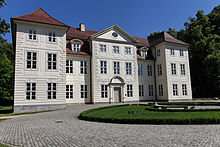The Neustrelitzer Kleinseenplatte or Mecklenburg Kleinseeplatte is a central region in the Mecklenburg Lake District in Mecklenburg-Western Pomerania and is popular with nature lovers because of its suitability for water hikes, hiking and cycling.

Regions / places
- the residential city Neustrelitz is the most important city in the region
- the town is centrally located Wesenberg
- in the West Mirow with its picturesque castle
- in the south East Fürstenberg (Havel) and Lychen
Other goals
background


In the Vistula glacial period about 15,000 years ago, a large glacier area abraded the land surface in what is now the Mecklenburg Lake District, creating valleys with channel lakes, which are connected by narrow passages or rivers, sometimes strung like pearls on a string.
Part of the region is connected to the watercourses Müritz, the largest German inland lake; the Elde flows from the Müritz via the Kölpin and Plauer See into the Elbe (and thus drains into the North Sea). The Havel spring lakes further east are the origins of the Havelwho initially face south and past Berlin turns west to also enter the Elbe to flow.
The whole area with flat hills and small lakes connected with canals and watercourses is partly used for agriculture, partly it is forested and the banks of the lakes are covered with reeds, the boggy water is usually a bit cloudy but clean.
language
German is spoken ...
getting there
By train / bus
Of Berlin one reaches Neustrelitz with the RE 5 every hour in about 1 h 15 min. The RE 5 service is also offered every hour from Stralsund above Neubrandenburg offered every two hours from Rostock above Guestrow. From Neustrelitz you can take the regional trains from Hanseatic Railway the Kleinseenplatte with the cities Wesenberg and Mirow alternatively you can use the bus.
In the street
From the south you can get from the Berliner Ring (![]() ) about the
) about the ![]() and the
and the ![]() exit
exit ![]() Röbel about the
Röbel about the ![]() through Vipperow Mirow, Wesenberg and after Neustrelitz.
through Vipperow Mirow, Wesenberg and after Neustrelitz.
An alternative is the approach from the ![]()
![]() Neuruppin about the German avenue street
Neuruppin about the German avenue street![]() above Rheinsberg to Wesenberg or the
above Rheinsberg to Wesenberg or the ![]() from the Oranienburger Kreuz via Löwenberg, Gransee and Fürstenberg Neustrelitz leads.
from the Oranienburger Kreuz via Löwenberg, Gransee and Fürstenberg Neustrelitz leads.
mobility
In the area of the various lakes of the Neustrelitz Lake District, you can often not easily get to the small towns at the various lakes (to use the boat or to start a hike) by public transport Hanseatic Railway drives the route Neustrelitz - Wesenberg - Mirow, the region is also supplied by various bus routes, some of which are on-call bus services.
Tourist Attractions



1 Neustrelitz
- The circular one is located in the center of the royal seat Marketplace with the City Church and the town hall.
- the Residential palace burned out in 1945 and was torn down until 1950, which was retained 1 Castle Park with the Rondell and the Luisentempel, the Kavaliershaus and the Schlosskirche.
- the 2 Harbor areaCity harbor with huge storages was restored.
- at the Glambeck lake is this 3 Carolinum High School located.
2 Mirow
- on the Mirow Castle Island, which is reached via a bridge with a gatehouse from the Renaissance, it says 4 Mirow Castle, a secondary residence of the dukes of Mecklenburg-Strelitz and opposite the Kavaliershaus and the Johanniterkirche. The Love island reached, in the park the tomb of Adolf Friedrich VI., the last Grand Duke of the Mecklenburg-Strelitz region.
3 Wesenberg
- the 5 Wesenberg Castle comes from the 13th century.
- near the market square is the 6 Gothic town church
- in the Villa Dandelion is that Tin Toy Museum.
4 Fürstenberg / Havel
- the 7 Fürstenberg City Palace on an island north of the old town is surrounded by watercourses.
- the 8 Evangelical town church was built in 1845.
- north of the Schwedtsee lies the 9 Ravensbrück memorial site
5 Lychen
Lychen belongs to the natural area of the Neustrelitz Lake District, politically it is part of the Uckermark district.
- the 10 City Church of St. John is a Gothic stone building from the 13th century.
- the 11 town hall on the market square was in the 18th century. built in baroque style.
- the 12 Rafting Museum refers to an economic branch that is historically important for urban development.
The main attractions are the ubiquitous lakes that are featured in the article on Water hiking as they are best experienced from the boat.
activities
- the Neustrelitzer Kleinseenplatte is mainly for the possibilities of Boat tours known, it can house boats, motor boats and yachts and canoes for Water hiking be hired.
- several lakes are used by the ships of the Blue and white fleet Mirow drive on.
- There is a dense network of hiking trails in the region
- the relatively flat area with little-traveled back roads that lead past the lakes are ideal for cycling.
kitchen
- In the region, fish specialties (especially smoked fish) are often offered, in many places Fish rolls offered.
nightlife
- to go out one drives into the cities, after Neustrelitz or Neubrandenburg
security
The security situation is harmless with regard to crime; On the water there is a risk for non-swimmers and surprise swimmers who have become seriously drunk after falling into the water. In dry late summer / autumn there is often a high risk of forest fires in the pine forests; open fires are prohibited during this time.
climate
literature
- Mecklenburgische Kleinseen 1 & 2, canoe compact - guide, Thomas Kettler-Verlag, each approx. 10 €

-IMG_2165.jpg/160px-Stadtkirche_Fürstenberg_(Havel)-IMG_2165.jpg)